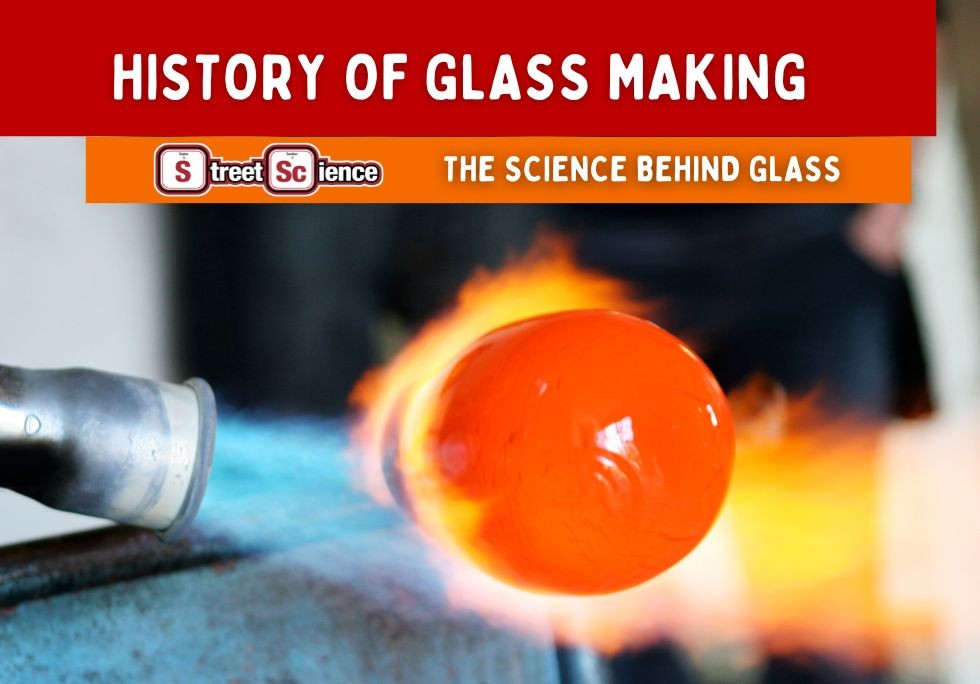Glass is pretty much everywhere these days – it’s in our windows and doors, cars, computers and even mobile phones. One of the world’s oldest and most useful building materials, glass actually dates back more than 4000 years. The earliest types of glass weren’t as clear as the window panes you see around your home, but they led the way in turning glassmaking into one of the world’s biggest industries.
It’s taken a long time for humans to perfect glassmaking. Even though glass is now affordable, there was a time when only the wealthiest people could afford to use it. We’re going to take a tour back through time and find out where glass came from and how it went from a rarity to a common building material!
What is Glass Made From?
Let’s start with a quick look at what glass is made from. At its core, glass is a very simple material, and most of the glass you see around you is made from a mixture of silica (which is a type of sand), sodium carbonate (also called soda) and calcium oxide (also called lime).
Soda-lime-silica glass is cheap to make and it’s extremely easy for glassmakers to work with. The three ingredients are combined and melted together in a kiln until they hit about 1675°C. At this point the glass ingredients form a molten liquid – almost like molten lava. From there, the glass can be shaped into just about anything, from window panes to glass bottles, phone screens and more!
Ancient Glassmaking
While modern humans have perfected soda-lime-silica glass, the process was actually pioneered by some of our oldest civilisations.
The exact origins of glassmaking aren’t clear, but the earliest examples of man-made glass date back more than 4,000 years to ancient Mesopotamia in the Middle East. Those early pieces of glass were mostly limited to simple objects like beads. But, it didn’t take long for glassmaking to travel from Mesopotamia to Ancient Egypt where it was first used to make glass bottles in 1450 BC. The first glass bottles were incredibly rare and difficult to make, as a result they were usually owned by royalty.
While we aren’t sure how glassmaking was discovered, it’s thought to have evolved from pottery making. A slow process of experimentation led potters to perfect recipes for molten glass which could be shaped around a core object (usually made of iron) to create vessels like bottles.

The Invention of Glass Blowing
Although Ancient Egyptians worked hard to perfect their glassmaking, it was the Phoenecians who developed glass blowing, a technique that’s still in use today.
Around 50 BC, the Phoenecians introduced glass blowing into their glassmaking industry. Using a long, hollow tube made of iron, the glassmaker could gather up a blob of molten glass and then blow air into the tube to create shapes from the glass. This works a lot like blowing up a balloon, except the glass hardens quickly as it cools, meaning glass blowing can be used to make complex shapes like cups and bottles.
Glassmaking in the Middle Ages
The Phoenecians perfected glass blowing, but the skill largely died out in Europe as the Roman Empire began to decline around 200 AD. As the techniques were lost, good glass making materials also became harder to find, and this meant that glass made during the middle ages was often low quality.
It wasn’t until nearly 1000 years later that the glassmakers of Venice began to revive the industry. By the year 1300, the Venetians had redeveloped many of the glassmaking skills used by the Phoenecians and the Romans, and they were doing their own experiments to improve the techniques, materials and finished products.
The Chemistry Revolution and Modern Glassmaking
Venice remained the world’s biggest producer of luxury glass products for hundreds of years. But, as chemistry took a giant leap forward during the 1800s, the science of glassmaking also became better understood.
Chemical formulas for making glass were developed, which paved the way for large-scale glass production of soda-lime-silica glass in the mid 1800s. Experiments by French chemist Jean-Baptiste-Andre Dumas led the way, and he eventually developed the formula for soda-lime-silica glass that’s still used today.
For thousands of years most types of glass were blown using the same ancient techniques. But, with Dumas’ discoveries and industrial manufacturing, modern glassmakers eventually developed the “float glass” process. Float glass produces the perfectly flat and clear pieces of glass that you see all over your home. In this process, soda-lime-silica glass is heated until it’s molten, and then it’s poured out onto a molten bed of tin as a thin sheet. The molten glass floats on top of the heavier tin and settles out into a perfectly flat sheet. It’s then cooled slowly and cut into large panes that can be anywhere from 2 – 22mm thick.
Dive Into the Science of Glassmaking With Street Science!
It’s little wonder that glass is one of the world’s oldest and most popular building materials. Glass has made much of our modern world possible, and there’s more than meets the eye when it comes to glassmaking! New for National Science Week 2022 is our BREAKING POINT stage show where we dive into the science of glass and learn more about this marvellous material. In this action packed show, Street Science’s presenters explore all the common questions about how glass is made and used, and it all ends in a smashing good time as we test the strengths and weaknesses of the glass that’s all around us. Contact us if you’d like to book your students into our BREAKING POINT live show or any other workshops put on by the Street Science team!




